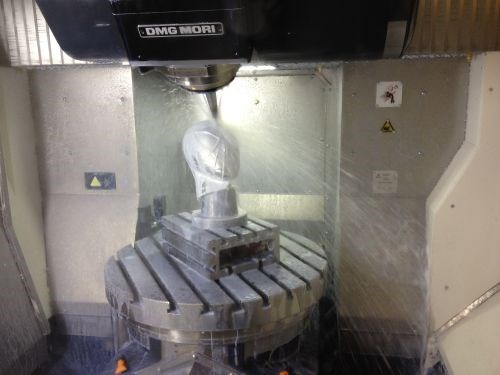A Fifth Five-Axis Myth
An article in our May issue covered a few of the more common myths about five-axis machining. Here’s one more for the list: Programming these machines isn’t as hard as one might think.

An HSC 70 Linear machining center carves out Spiderman's head at DMG MORI's "Innovation Days." The company's Jeff Wallace says programming five-axis routines is not as difficult as many seem to believe.
Jeff Wallace looked frustrated when I asked him about the adoption of five-axis machining among U.S. mold manufacturers. Asked why shops here in the ‘states haven’t kept up with their counterparts elsewhere, he said some of it boils down to stubbornness—toolmakers getting so vested in their ways that they’re reluctant to try anything new. Beyond that, however, many toolmakers simply need an education.
Wallace speaks in part from personal experience. Although today he’s general manager of national engineering at DMG MORI, his background is in moldmaking. Thus, I ended up spending quite a bit of time with him at the machine tool builder’s recent “Innovation Days” event a few weeks back at its Chicago-area headquarters. Among other developments, I learned about technologies that enable texturing and even polishing molds while still on the machining center.
However, it all starts with carving cores and cavities; and for that, five-axis machines offer substantial productivity gains. However, some moldmakers might view the learning curve of programming two additional axes as too steep to justify an investment, at least in the near-term. Generally, however, such views are misplaced, Wallace says.
For one, modern CAM systems take care of many of the most tedious aspects of programming behind the scenes. That might irritate experienced users like Wallace, but most systems still provide access to the “nuts and bolts,” as it were, for folks like him. Meanwhile, the barrier to entry for five-axis isn’t nearly as daunting for those still learning the ropes. Beyond that, full, simultaneous five-axis machining is far less common than 3+2, in which the cutting tool is locked in a tilted position using the two rotational axes. As Wallace points out, plotting tool paths for 3+2 routines is really no different than programming a typical three-axis operation.
Wallace’s comments about programming would have fit well in a May issue article covering four other myths of five-axis machining, including misconceptions about losing rigidity; high maintenance costs; the benefits of 3+2 versus simultaneous five-axis; and the differences between trunnion style and swivel-head machine models. Learn more here.














.jpg;maxWidth=300;quality=90)

